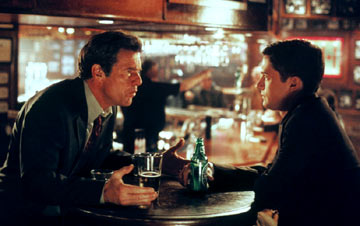In Good Company: Baked Ziti-A La Italian
/Year Released: 2005
Directed by: Paul Weitz
Starring: Dennis Quaid, Topher Grace, Scarlett Johansson
(PG-13, 131 min.)

"He has achieved success who has lived well, laughed often, and loved much." A. J. Stanley
Scarlet Johansson utters the film's critical death knell when her character says, “I’m cursed with an utterly functional family.” Not surprising that most critics could barely mete out two stars. I say it's unexpectedly fresh and definitely worth watching.
Lost in Translation’s iconic ingénue, alternative film’s femme fatale Johansson is also cursed by being cast opposite Dennis Quaid, whose cocky smirk in earlier works ushered him into that vile pile of mediocrity and condescension that Tom Cruise still struggles to claw his way out of.
In Good Company, an ironic pun with many facets, offers some perceptions, if not profound, then at least insightful, like putting a human face on corporate takeovers, or examining the courtship dance of the modern woman.
Dennis Quaid as Dan Foreman seems to have come of age in the film, playing a successful ad man slightly out of touch with the tech generation. He’s Jack Nicholson in About Schmidt, some fifteen years younger, but happily married (Oh! Oh!), and utterly devoted to his daughters with all the paranoid protectiveness of a father with babes on the verge of leaving the nest.
In the opening scene, Dan frets needlessly when he finds an early pregnancy test in the kitchen garbage, only to find out it is he who is going to be a father again. “Let’s see I’ll be 72 -- 73,” his wife corrects him," when he is 21,” reminding us that no matter how old, a man is always dreaming of a son.
And while Dan is digesting this surprise, he find his company in the midst of a corporate buyout, and gets the disturbing “good” news that his oldest daughter Alex has been accepted at tuition rich NYU and wants to transfer there. How this ordinary and decent everyman copes with these three crises is the grist of the film.
In Good Company also plays with expected convention and yields more than a few surprises. It is a kind of rites of passage film for an unpredictable world when corporate cataclysms jerk us out of orbit. Just when we feel easy in a comfortable cliché or an early victory we are jerked out of our complacency. The pregnancy kit is not for Alex; she sleeps sweetly in her childhood bedroom as Daddy looks in. But just when we are reassured of her innocence, she disabuses us of that notion.
Somewhat like Samuel Becket’s Waiting for Godot, just when In Good Company lurches toward sentimentality, it jerks us back to earth with a vaudevillian pratfall. Tofer Grace’s Carter Duryea, the disgustingly young (26) corporate replacement for Quaid, is on top of the world. He buys a 911 Porsche and dons to-die-for dark glasses reminiscent of Tom Cruise in Risky Business with almost as disastrous results. Nursing the wounded Porsche Beast back home, he is greeted by his new bride, suitcases packed on her way back to Mom and Dad. So the young Buck has his problems, too.
Then there is the company basketball match, with the corporate opponents flaunting their seven foot wonder while Quaid asks aloud,” Can I still dunk?” Results may surprise.
Or the unexpected twists as young buck Carter and daring daughter Alex feint and parry their way through a developing relationship. In fact, the enigmatic complexity of Alex’s character is one of the most memorable aspects of the film.
Not a new story, but neither was Hamlet. In Good Company is just that—a nicely done ensemble with strong performances that elevate a predictable comedy to something more – something that asks us as much about the human predicament as it discloses.
—Kathy Borich

Film-Loving Foodie
Okay, the casserole falls to the floor and shatters. All that is left are the pottery shards, which I guess you could pick up with gobs of ziti on them in the way of non-edible tortilla chips or kind of crude spoons. But the baked ziti stands as an emblem of everything Quaid’s utterly functional family stands for. Ziti, not “pasta,” with all its pretentiousness. And "casserole"– is there anything that says family, home, and contentment with all its carb comfort more than that?
It is that dish that New Yorkers cook up in Sunday afternoon kitchens where refrigerators are decorated with crayon pictures. And if it is a real Italian house, it may be heated in the basement oven to keep the house from getting too hot.
Contrast that with Carter’s infatuation with Sushi and you understand the two worlds in conflict In Good Company. After much pleading on Carter’s part, Dan takes a bite and (rightly in my opinion) labels it “raw fish."
I’ll let you find your own Sushi. If you’d like to cook up some baked ziti, here’s a recipe.
(I’ve had to cool my Italian blood and opt for a more American version of the ziti, which is really the way Dan‘s wife Ann probably cooked it. Notice that it uses ground beef, spaghetti sauce from a jar, and gives the option of using cottage cheese instead of ricotta.
If you want to have a more New York "gumba" style version, prepare your own sauce, and throw in some sautéed mushrooms, peppers, and onions. You can use a couple of fresh cloves of garlic, even keeping them whole if you like, instead of the minced version. Substitute Italian sausage for a tastier casserole, or boneless chicken strips for a more diet conscious one.)
Buono Appetito!
Baked Ziti-A La Italian
1 (16 oz.) box ziti macaroni
1 lb. ground meat
1 lg. jar spaghetti sauce
1 (1 lb.) box cottage cheese or ricotta cheese
8 oz. Mozzarella cheese, diced
1 tsp. minced garlic
1/4 tsp. oregano
Dash of salt
Olive oil
Boil macaroni according to directions on box, drain, and cool. Brown meat in olive oil. Add oregano, garlic, and salt. Mix ingredients and put in oblong baking pan. Cover with foil. Bake 40 minutes at 350 degrees or until very bubbly. Bake, uncovered for the last 5 or 10 minutes.
Recipe Source: cooks.com















